Slavery
You cannot possibly be in the Caribbean learning about the
history, tradition, flora and fauna without the words - sugar - plantation -
slavery.
Early mention of the slave trade in Europe:
The government in Spain ordered its agents in Seville to send out 250 slaves for
the gold-mines of Hispaniola; and from 1518, in order to forestall Portuguese
smuggling, the crown began to grant licenses to private traders for the import
of slaves into the West Indies. In this way the third racial element was added
to the West Indian mixture. By the late 1520's all the disciplinary problems of
plantation slavery had made their appearance: shortage of European supervisors -
partly due to the exodus to Mexico; servile mutinies; bands of runaways hiding
in the mountains and emerging at intervals to attack the settlements. Even so,
the planters constantly clamoured for more slaves. There were never enough.
Import was by individual license, though sometimes a monopoly for a period
of years might be granted, with the right to sell individual licenses to
sub-contractors. The licensees had to buy their slaves from Portuguese dealers;
the supply was haphazard and irregular; and the island buyers had to compete
with larger producers of sugar on the mainland.
 
At first settlers in America imported cane sugar from the West
Indies, however, after the US purchased the Louisiana Territory from France in
1803, plantation owners began growing sugar cane. The crop was labour intensive
and large numbers of slaves were purchased to do the work. The crushed
cane was used for fuel, molasses and as a base for rum. The industry grew
rapidly and by 1830 New Orleans had the largest sugar refinery in the world with
an annual capacity of 6,000 tons.
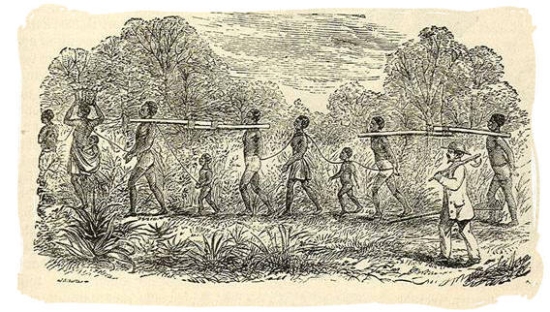 
Human cargo: The triangular voyage was usually
at least twelve months. A ship would sail from its home port in England or
France with a cargo of 'trade goods' - woolen or cotton cloth, firearms, other
weapons, tools, pots, pans and trinkets. When the ship arrived off the
African Coast, negotiations begun, usually through resident middle-men, most of
whom were Portuguese half-castes, for slaving the ship. Slaves might be picked
up in small lots here and there; or more commonly assembled in bulk, or in
barracoons ashore. All this trading might take several weeks. Meanwhile, 'trade
goods' were landed in payment, water barricoes filled ashore and temporary decks
constructed by the ships carpenters. On these extra decks the slaves were to
travel, lying prone all night and most of the day as there was no room to sit
upright let alone stand. As soon as the cargo was assembled the slaves were
hurried on board, the ship set sail without delay, carronades trained inboard
and gunners mates standing by with lighted matches until the Coast was out of
sight. Ships’ captains mixed slaves from different nations, creating a language
barrier that prevented the captives from plotting to take over the ship.
Captives usually outnumbered sailors by ten to one on these ships, who suffered
on the voyages almost as much as the slaves and few highly skilled seamen would
join such a ship. Women and children were held in separate quarters and
were at risk of being attacked or abused by the sailors during the
voyage. Once at sea the danger of mutiny was less so some deck exercise was
permitted, though always under strict guard. Ships arrived in the islands after
this middle passage in which speed was of the essence as this was the best
safeguard against mortality, the process was reversed; the slaves might be sold
on board if demand for them was urgent, but usually they were landed,
'refreshed' for a short period ashore on fresh provisions, doctored in
various ways to improve their health and appearance, and then sold at auction,
in small lots, by the agent of the slaving firm, to factor's or local
planters. Planters were bad payers and many of the transactions involved credit.
Unless there was a great shortage of slaves, the planter usually had the
advantage in these trades. The process of sale or
barter might take many weeks. For the ships company this was a time of rest and
release from strain, for once a slave was sold his new owner was responsible for
him. Ship's discipline relaxed; many seamen deserted in the West
Indies, others had to be signed on, usually at rates of pay far higher than
those ruling in Europe - a frequent cause of dispute. Some worn out ships also
remained in the islands, being judged unequal to the homeward passage. The
French but not usually the English, enforced a system to determine seaworthiness
at this stage. Eventually, sales made, crew rounded up and formalities done, the
ships people dismantled the added slave decks and loaded in the return cargo,
usually sugar, for the last leg of the triangle, usually the quickest back to
Europe.
  
The crew had to load enough water for every person on board, at
least several hundred barricoes. If the cooper was incompetent everybody may die
mid-Atlantic. The carpenter, similarly, was responsible not only for ordinary
structural repairs but for the maintenance of several hundred leg-irons,
neck-rings and pairs of manacles; woe betide officers and crew if slaves
shackles broke while the ship lay off on The Coast. Even the cook had an unusual
task, in having to cater for several hundred slaves in addition to the ship's
company. The senior officers, the captain in particular - needed a high
degree of professional competence, be excellent seamen, had to be
specialised merchants, warders, diplomats and on occasion fighting men. They
were well paid by comparison to most other trades, both in salary and with
opportunities for private trade. They were not necessarily, or usually brutal
sadists of abolitionist propaganda; they did not suffer social stigma by reason
of their trade in the eighteenth century - certainly they were not regarded as
monsters. On the contrary, like merchant officers in other trades, they took a
normal pride in delivering their special type of cargo in as good a
condition as possible. The standing orders of most slaving firms forbade
officers and seamen to strike or ill treat slaves. It took only a few
slaving trips, however to rob a man of any sense of the humanity of the slaves
he carried; for him they became so many cattle, to be treated with no more
or no less consideration than other animals of commercial value. In 1811 on Tortola in the British
Virgin Islands, Arthur William
Hodge, a wealthy plantation owner and Council
member, became the first and only person to be hanged for the
murder of a slave.
  
Death at sea: The European crews made sure that slaves were
fed and exercised regularly. Slave ships carried various tools and instruments
to force captives to eat including small hammers and chisels to remove teeth to
overcome hunger strikes. Captives were exercised by being forced to dance and
jump on the deck, sailors would take this opportunity to wash their
prisoners with cold sea water, this they thought helped maintain good
health. However, when disease spread and began kill captives the crews
would throw dead and dying overboard to protect the rest of their
valuable cargo. When ships took longer than expected to sail across the Atlantic
and food and water supplies ran low, many captives were thrown overboard to
ensure that there would be enough supplies for the European crew. Employment in slavers was not only exacting; it was obviously
unpleasant, often dangerous and nerve-racking. Apart from the ever-present
danger of insurrection, ships lay off-shore for weeks on end in hot and
unhealthy estuaries. An outbreak of an infectious disease in the packed
conditions during the middle passage would kill off the greater part of the
company and cargo, hence the insistent regulations about scrubbing decks and
sprinkling with vinegar etc. Even the regular rate of mortality among the crews
of slavers was very high, 20 to 25% on average, and this in an age when health
at sea in general was improving and the incidence of diseases such as scurvy was
being rapidly reduced. It is significant that the death rate among the crews was
usually about the same as amongst the slaves themselves.
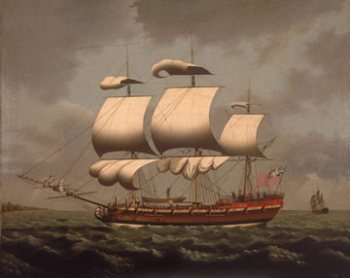
 
Jackson out of Liverpool, extra decks added to carry slaves and The Fluyt of the Netherlands.
A profitable trade: Two out of every five slave ships
sailed to and from ports in the North and South America, and the Caribbean.
Filthy slave ship holds were not suitable for carrying most goods back to
Europe. Instead, other ships transported sugar, tobacco, rice, timber and other
colonial produce back to Europe for sale or to be processed into manufactured
goods. For nearly 100 years sugar remained Britain’s largest and most valuable
import from the slave colonies, only overtaken by cotton in the 1820's. Glasgow
and Greenock on the River Clyde benefited from the triangular trade as their
ships could sail to and from many North American ports on this third leg of the
trade quicker than ships from Liverpool, Bristol or London. Merchants who
participated in the triangular trade became powerful citizens in Britain’s major
sea ports.

Wealth from slave trade: Nearly thirty of Liverpool’s
mayors between 1700 and 1820 were slave merchants, also many MPs and members of
the House of Lords grew rich from the trade and retired to large houses in
Britain to enjoy their fortunes. Thousands of ordinary Britons relied on
the slave trade for their employment at sea or on shore. Ships had to be built,
fitted out and repaired. Dock workers, blacksmiths, carpenters, sail-makers and
rope-makers worked all year round on Britain’s slave trade fleet. Many Britons
found jobs in banking and insurance supplying services to slave merchants. The
wealth and prosperity of many communities depended on the slave trade.

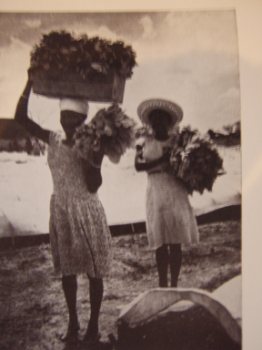 
Slaves raking over the coffee beans to dry
in the sun, carrying tobacco leaves and working in the fields.

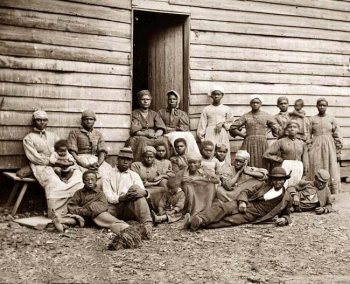 
Just some of the children taken,
workers in the southern US taking a break, many
movies have been made showing the plight of
slaves.
Fine of £100 per slave; The transatlantic slave trade ended
and the campaign, supported by tens of thousands of Britons was victorious. The
Abolition of the Slave Trade Act banned British ships from taking part in
the trade. Any slave ship captain was liable to a fine of £100 per captive
and his ship could be confiscated. Ship owners, officers, ship’s surgeons and
anyone else participating in the slave trade could also be fined. Insuring slave
ships was banned and companies were fined £100 for any policy issued. Enemy
ships caught with captives aboard became the property of the British
government.
Britannia rules the waves: Nelson’s victory at Trafalgar in
1805 destroyed the French and Spanish fleets and made Britain safe from foreign
invasion. Control of the seas meant that Royal Navy ships could stop and search
any ship at sea, hoping to outlaw the trade in African slaves. Huge profits
still attracted slave traders and sea captains to risk fines but British law for
the first time made their activities illegal. At the same time, the sugar
plantations on the captured French and Spanish islands were not able to obtain
fresh supplies of captives to compete with the British colonies. The boom was
slowing.
Slavery in the British and French Caribbean: The islands of
Barbados, Antigua, Martinique and Guadeloupe in The Lesser Antilles were the first important slave societies of the
Caribbean, switching to slavery by the
end of the 17th century as their economies converted from
tobacco to sugar production. By the middle of the 18th century, British
Jamaica and French
Saint-Domingue had become the largest and most
brutal slave societies of the region, rivaling Brazil as a destination for enslaved Africans. The death rates
for black slaves in these islands was higher than birth
rates, caused by overwork and malnutrition, slaves
worked from sun up to sun down in harsh conditions, supervised under demanding
masters. Slaves had poor living conditions, little medical care and consequently
they contracted many diseases.
The lodging, clothing and feeding of these armies of
slaves was one of the major problems of the West Indian economy. Slaves usually
built their own huts of timber, thatch and wattle-and-daub, mostly grown on the
estate. More substantial buildings would have to be roofed with imported
shingles, which was expensive. They wore clothes supplied by their owners - two
suits per year was the usual allowance in both the French and British islands -
and various types of coarse linen cloth - osnaburg, Dutch Stripes and Guinea
Blue - were manufactured expressly for this market in England and France. As for
food, the proprietor of a plantation could import it, grow it on part of
his land, or allow land and time to his slaves to grow it for themselves. In
Saint-Domingue and Jamaica, which were the chief sugar planting areas in the
eighteenth century, it was the custom to set aside marginal land, usually in the
foothills, as provision grounds.
For centuries the slave trade made sugarcane production
possible, the low level of technology made it a difficult and labour
intensive product. At the same time, the demand for sugar was rising,
particularly in Great Britain. The French colony of Saint-Domingue quickly began
to out-produce all of the British islands' sugar combined. Though sugar was
driven by slavery, rising costs for the British made it easier for the British
abolitionists to be heard.
With abolition the new British colony of
Trinidad was left with a severe shortage of labour,
this shortage became worse after the abolition
of 1833. To deal with this problem, Trinidad imported
indentured servants from the 1830's until 1917.
Initially Chinese, free West
Africans and Portuguese from the island of Madeira, but they were soon supplanted by
Indians. In addition, numerous former slaves
migrated from the Lesser Antilles to Trinidad to work.
  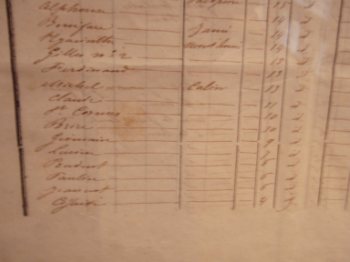
An inventory of taken slaves on the left the
oldest is 68 on the right the youngest is 4 years old. The central
photograph famously shows Peter Baton's back covered
in scars from his beatings.
Whitehall in England announced in 1833 that slaves
would be totally freed by 1840. In the meantime, the government told slaves they
had to remain on their plantations and would have the status of
"apprentices" for the next six years. On the 1st of August 1834, an
unarmed group of mainly elderly Negroes being addressed by the Governor at
Government House about the new laws, began chanting: "Pas de six ans. Point de
six ans" ("Not six years. No six years"), drowning out the voice of the
Governor. Peaceful protests continued until a resolution to abolish
apprenticeship was passed and de facto
freedom was achieved. Full emancipation for all was legally granted ahead of schedule on the
1st of August 1838, making Trinidad the first British colony to
completely abolish slavery. After Great Britain abolished slavery, it began to
pressure other nations to do the same. France, too, abolished slavery. By then
Saint-Domingue had already won its independence and formed the independent
Republic of Haiti. French islands were limited to
the Lesser Antilles.
Slavery and negotiating freedom: Between 1662 and 1807
Britain shipped 3.1 million Africans across the Atlantic Ocean in the
Transatlantic Slave Trade . Africans were
forcibly brought to British owned colonies in the Caribbean and sold as slaves
to work on plantations. Those engaged in
the trade were driven by the huge financial gain to be made, both in the
Caribbean and at home in Britain. Enslaved people constantly rebelled against
slavery right up until emancipation in 1834. Most spectacular were the slave revolts during
the 18th and 19th centuries, including: Tacky’s rebellion in 1760’s Jamaica, the
Haitian Revolution (1789), Fedon’s 1790's revolution in Grenada, the 1816
Barbados slave revolt led by Bussa, and the major 1831 slave revolt in Jamaica
led by Sam Sharpe. Also voices of dissent began emerging in Britain,
highlighting the poor conditions of enslaved people. Whilst the
Abolition movement was growing, so was
the opposition by those with financial interests in the Caribbean. The British
slave trade officially ended in 1807, making the buying and selling of slaves
from Africa illegal; however, slavery itself had not ended. In 1811 an Act of
Parliament made slave trading illegal, in 1827 it was declared to be piracy and
punishable by death. Other nations legislated against the trade; Sweden in 1813,
Holland in 1814, France 1818 and Spain in 1820, these latter two powers
were half-hearted about the matter and slave dealing was an open business
in ports like Nantes, which had some eighty slave ships and where the profits
from the trade were said to have amounted to 90,000,000 francs in the year 1815.
The total number of slaves taken from West Africa after the Abolition Act of
1808 may in fact have been greater than those taken before that date; it is
certain that both Cuba and Brazil imported greater numbers after 1808 than they
did during the earlier period, Cuba was importing slaves up to 1865, Brazil even
later. In Cuba and the US the demand for slaves increased after 1808 because of
the greatly expanded production of sugar, cotton and tobacco.
It was not until the 1st of August 1834 that slavery ended
in the British Caribbean following legislation passed the previous year. This
was followed by a period of apprenticeship with freedom coming in 1838. Even after the end of
slavery and apprenticeship the Caribbean was not totally free. Former enslaved
people received no compensation and had limited representation in the
legislatures. Indentured
labour from India and China was introduced after
slavery. This system resulted in much abuse and was not abolished until the
early part of the 20th century. After indenture, Indians and Africans struggled
to own land and create their own communities.
One of the simplest ways to understand the changing sentiment
over time in Europe is to view the changes by year and country:
-
1792. Denmark. A partial ban on the
slave trade is passed and put into effect in 1802.
-
1806. Britain.
Sale of slaves to non-British colonies is banned.
-
1807. Britain.
Import of slaves to British colonies is banned and outlawed the following
year.
-
1807. Denmark. Total ban on all slave
trade.
-
1814. Netherlands Slave trade outlawed.
-
1818. France. Slave
trade outlawed.
-
1820.
Spain. Slave trade formally
outlawed, but illegal trade to Puerto Rico and Cuba tolerated until the 1850’s
and 1860’s.
-
1834. Britain.
Slavery abolished, though apprenticeship period was set to last until 1838.
-
1848. Denmark. Slavery abolished.
-
1848. France. Slavery
abolished. The 23rd of May abolition in Martinique, 27th
May in Guadeloupe. 10th of August in French Guyana, 23rd
of August trading posts in Goree and Saint-Louis in Senegal.
December the 20th Reunion Island.
-
1848. Netherlands. Slavery abolished on Sint Maarten.
-
1848. Netherlands. Slavery abolished on other
colonies.
-
1873. Spain. Puerto Rico's slavery is abolished.
-
1879. Spain. Abolition on Cuba, but unpaid labour required
until 1886.
The abolition of the slave trade in Britain had a strong effect
throughout the Caribbean, as the English were the suppliers of many other
islands' slaves.
Religion and Slavery: The enslaved part of the
population went through an initiation of sorts. Newly arrived slaves had to
be 'seasoned', that is, they had to be given time to adjust themselves
physically to their new environment. They learnt their work under the direction
of a driver or from a Creole slave, the traders were taught by craftsmen
brought out from England. The purpose of training was to get as much value as
possible in labour from the slave, and the same purpose directed the
training of the children through the 'Pinckney gang'. The only people who
thought slaves should be taught to read and write were the missionaries. The
planters regarded literacy as a sort of social dynamite, but in 1760 the
Moravians were allowed to begin the instruction of slaves in the Christian
religion because they taught acceptance of the rule of the master. As the
evangelical movement gained in strength in England the habit of reading the
Bible spread, and out of this there sprung a mass movement in literacy in
England in the early nineteenth century. At the same time in the West Indies the
missionaries pressed forward with their efforts to christianise the slaves. In
1797 the Barbados Consolidated Slave Act made it the duty of every Anglican
rector to set a time every Sunday for instructing the slaves in the doctrines of
Christianity, but it was illegal to teach reading and writing. Real education
did not begin until well after 1838. In Britain particularly, religion became an
important reason not to participate in slavery. However, religious motivations
were not part of the abolition movements in other countries. In France and
Spain, public officials and intellectuals made up the majority of abolitionists.
In these countries and other Roman Catholic nations, the majority of the
religiously affiliated abolitionists were Protestants. In fact, the pope did not
condemn slavery until 1839, and Britain was responsible for the pressure on
other nations to stop using slave labour.
Rising Sugar Costs: One of the most important early
arguments for slavery was that it kept the cost of sugar low. However, the
British islands, particularly Jamaica, were having trouble proving this point.
In fact, the British government headed a number of initiatives to help improve
the quality of life for the colonial slaves, including the amelioration
initiative in 1823. Nothing could stop the price of British sugar from
skyrocketing, and the increase in sugar consumption had made it difficult for
Britain to handle the rise in cost. When it became clear that the rising price
of sugar could not be stopped with slavery, Britain became more forceful with
its most rebellious colony, Jamaica, whose Assembly had resisted all abolition
measures at every turn.

An article that appeared in
Harper's
Abolition in Britain: Rebellions were another drain on
slavery. These increased greatly throughout the British islands after 1815.
While some attribute these revolts to worsening conditions brought on by
abolition, which forced harder work from already overworked slaves, others blame
it on the rapid spread of Protestant Christianity among the slaves. A slave
rebellion led by Baptist preacher Samuel Sharpe began just after Christmas in
1831, and more than 200 sugar estates on Jamaica were burned and pillaged.
Regular troops fought the slaves, and 540 slaves died after the revolt was put
down. This outraged the English, but they were wary of Haiti's rebellion by its
slaves, so England created a period of compulsory work after abolition known as
"apprenticeship." In 1823, the historic Abolition Act was passed, and it ended
slavery in August of the following year. Agricultural workers would be required
to work for their former masters until 1840, but domestic staff would only have
to work until 1838. They would be allowed to buy their own freedom at any time.
The former slaves would be given food, clothing, lodging, medical care and in
return they would give 45 hours per week of unpaid labour. They could also work
on their own, for pay, during their free time, and Britain sent special
magistrates to settle any disputes. However, full abolition came about somewhat
earlier than planned, in 1838. The abolition of slavery in the British colonies
had long-lasting and far-reaching effects. However, the remaining European
nations did not place emancipation of their slaves as a top priority.
William Wilberforce (1759 – 1833) A very important
person in the abolition of slavery: William Wilberforce was a wealthy
young man and at 21 became MP for Hull in the Tory government led by his good
friend William Pitt. Wilberforce heard John Newton preach in London and became a
regular visitor to Newton’s house. Wilberforce listened to Newton’s descriptions
of the horrors of the slave trade. Abolitionists such as Clarkson and Sharp met
Wilberforce and persuaded him to join the Society for the Abolition of the Slave
Trade.
First Bill defeated: In 1789 Wilberforce made his first speech in
Parliament on the subject of ending the slave trade. Two years later Wilberforce
introduced a Bill (or draft law) in Parliament to abolish the slave trade. He
had the support of Pitt, the Prime Minister, he was an eloquent speaker
with a mountain of evidence gathered by Clarkson to support the case against the
evils of the trade in human cargo. However, the slave traders and slave owners
had too many friends and allies in Parliament. Wilberforce’s proposal was
defeated for the first, but not the last, time.
Extract from Wilberforce’s 1789 Abolition speech to Parliament.
This is known as one of the great speeches of history, the full speech lasted
almost 4 hours long: “I must speak of the transit (transport) of the slaves
in the West Indies. This I confess, in my own opinion, is the most wretched part
of the whole subject. So much misery condensed in so little room, is more than
the human imagination had ever before conceived…A trade founded in iniquity, and
carried on as this was, must be abolished, let the policy be what it might, -
let the consequences be what they would, I from this time determined that I
would never rest till I had effected its abolition“.
Long struggle: Every year, Wilberforce introduced a Bill to
abolish the slave trade in the House of Commons. Each year, the majority against
Wilberforce’s proposed new law got smaller until the House of Commons passed the
Bill in 1805. But the Bill was rejected by the House of Lords. It took nearly
twenty years for the number of MPs and Lords willing to end the slave trade to
outnumber those determined to see it continue. In 1807 Wilberforce’s Bill was
passed by both Houses of Parliament. 114 MPs had voted for the Bill and only 15
against. The Act for the Abolition of the Slave Trade made the slave trade
illegal throughout the British Empire. The Abolition Act put Britain out of the
slave trade at a time when more than one-half of the trade was in British hands.
It did not put an end to the trade itself, others moved in to take what the
British gave up and their were many English slave smugglers carrying on
supplying slaves. The US government declared the trade illegal in 1808, however,
many Americans continued to engage in the trade, evading the law by selling
their ships nominally to Spain.
No rest until slavery was abolished: Wilberforce, Clarkson,
Sharp and the other leaders of the abolitionist movement did not rest until
slavery was abolished throughout the colonies. The fight to end the trade was
won, but the anti-slavery campaigners knew that African slaves still faced lives
of extreme hardship and injustice. Wilberforce died on the 29th of
July 1833, three days after the Slavery Abolition Bill had been passed by the
House of Commons. He died knowing that at last slavery would be abolished
throughout the British Empire.

ALL IN ALL the fact of taking a person
from their home, family and life was wrong and had to be
abolished.
.
|

























